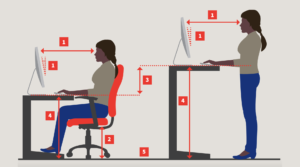Table of Contents
Ever Feel Like Your Neck Has a Mind of Its Own? You’re Not Alone!
Ever woken up with a stiff neck after a long train journey, or felt a twinge while scrolling through your phone? If so, you’re not alone. Neck pain is incredibly common in India, affecting nearly 3 out of 10 people, according to the Indian Spinal Injuries Association. That’s roughly the population of Mumbai!
But why is neck pain so widespread? It’s like a thief stealing our comfort, making simple tasks like turning to greet a friend or tying a dhoti feel like a struggle. Think about it: how often do you use your neck throughout the day? From nodding in agreement to looking down at your phone, it’s constantly working hard.
And just like any hardworking part of our body, sometimes our necks get tired and complain. This can lead to more than just discomfort, studies suggest a link between chronic neck pain and feeling stressed, anxious, or even having trouble sleeping. Imagine the impact that can have on our daily lives!
But here’s the good news: understanding neck pain is the first step to managing it. In the next sections, we’ll explore different types of neck pain, what might be causing it, and most importantly, what we can do to feel better.
Understanding Your Neck Pain: Acute, Chronic, and the Pain Scale Demystified
Ever wondered why your neck feels stiff after a long day on the bus, or experienced a sharp twinge while working on your laptop? That, my friend, is neck pain, a common complaint affecting millions in India. But what exactly is it, and how does it differ from the occasional ache everyone experiences?
Think of your neck as a complex tower of seven bones (vertebrae) stacked neatly upon each other, supporting your head and allowing for all those essential movements. When muscles, nerves, or other tissues in this area become irritated or injured, you get neck pain.
Now, here’s where things get interesting: neck pain can be acute or chronic. Imagine waking up with a stiff neck after sleeping awkwardly – that’s acute pain, usually lasting a few days to weeks and often resolving on its own. But if your neck aches for months on end, that’s chronic pain, potentially requiring professional attention.
But how do you measure this pain? Enter the pain scale, your handy guide to describing the intensity of your discomfort. Think of it as a ladder, with 0 being no pain at all and 10 being the worst pain imaginable. Most mild neck aches fall around 2-3, while severe pain might reach 7-8. Remember, it’s subjective, so choose the number that best reflects your experience.
Here’s an research paper on the cervical spine (your neck) and a pain scale from the National Institute of Neurological Disorders and Stroke (NINDS).
Understanding the type and intensity of your neck pain is crucial for seeking the right help. In the next sections, we’ll delve deeper into the various causes of neck pain, both acute and chronic, and explore different management and prevention strategies.
Unraveling the Mystery of Neck Pain: Acute, Chronic, and Beyond
Remember that crick in your neck after a long rickshaw ride, or the sharp twinge while using your phone? That’s just the tip of the iceberg – neck pain can manifest in various ways, each with its own story to tell. Let’s delve into the different types of neck pain, understand their causes, and explore the symptoms that might be knocking on your door.
3.1 Acute Pain: A Temporary Hitch in Your Ride
Think of acute neck pain as a sudden, short-lived visitor, often lasting a few days to weeks. It could be caused by:
- Muscle Strain: Imagine carrying heavy groceries for too long – the same can happen to your neck muscles from awkward postures, like slouching while working on your laptop.
- Whiplash: Ever been in a sudden jolt, like a car accident? That quick movement can strain your neck muscles and ligaments, leading to whiplash.
- Minor Injuries: Sports injuries, bumps, or falls can also cause temporary neck pain.
Remember, these situations often don’t require a doctor’s visit. Applying ice packs, gentle stretches, and over-the-counter pain relievers can help ease the discomfort. But if the pain persists or worsens, seeking professional help from a certified physical therapist or pain management specialist is recommended.
3.2 Chronic Pain: A Persistent Guest
Unlike its fleeting cousin, chronic neck pain can linger for months or even years. Some common culprits include:
- Pinched Nerve: Imagine a nerve getting squeezed between bones or tissues in your neck, leading to pain, numbness, or tingling. This is called cervical radiculopathy.
- Disc Herniation: The spongy discs between your neck vertebrae can bulge or rupture, putting pressure on nerves and causing pain.
- Arthritis: Just like in your knees, arthritis can affect the joints in your neck, leading to stiffness, pain, and swelling.
These conditions often require a different approach. Consulting a doctor for diagnosis and treatment is crucial, which could involve medications, physical therapy, or in some cases, even surgery. You can find relevant clinical studies or research papers on these conditions online from reputable medical institutions.
3.3 Other Causes: Less Common, but Important
While less frequent, other factors like tumors or infections can also cause neck pain. It’s important to consult a doctor if you experience severe pain, fever, or other concerning symptoms. You can find information about these conditions on medical websites or organizations like the Mayo Clinic.
Understanding Your Neck Pain: Symptoms and Risk Factors
Ever woken up with a stiff neck after a long train journey or felt a dull ache while working at your desk? Neck pain can manifest in various ways, each with its own set of red flags. Knowing these symptoms and understanding the potential culprits can help you navigate this discomfort and seek the right solutions.
4.1 Symptoms: Listen to Your Neck’s Whispers
Just like any part of your body, your neck communicates its discomfort through various symptoms. Here’s a breakdown for different types of neck pain:
Acute Pain:
- Stiffness: Imagine waking up feeling like your neck is stuck.
- Sharp pain: A sudden jolt or awkward movement can cause a sharp twinge.
- Limited movement: Turning your head might feel difficult or painful.
Chronic Pain:
- Dull ache: A constant, nagging pain that may worsen with certain activities.
- Headaches: Pain radiating from your neck to your head, especially at the base.
- Numbness or tingling: A prickly or numb sensation in your shoulder, arm, or hand.
- Weakness: Difficulty lifting objects or performing daily tasks due to neck weakness.
4.2 Risk Factors: Unmasking the Culprits
While anyone can experience neck pain, certain factors put you at a higher risk:
- Poor posture: Slouching while working, watching TV, or using your phone strains your neck muscles.
- Repetitive movements: Jobs or hobbies involving repetitive neck movements can lead to overuse injuries.
- Stress and anxiety: Chronic stress can tighten your neck muscles and contribute to pain.
- Lack of physical activity: Inactivity weakens muscles, making them more susceptible to injury.
- Previous neck injuries: Old injuries can increase your risk of future problems.
- Being overweight: Excess weight puts extra strain on your neck and spine.
For more detailed information on specific neck pain symptoms, you can refer to the American Academy of Orthopaedic Surgeons website :
When to Say “Namaste” to the Doctor: Recognizing Neck Pain Red Flags
Neck pain is a common foe, but sometimes it’s a sign of something more serious. So, how do you know when to seek professional help instead of relying on home remedies? Here are some red flags that warrant a doctor visit:
- Severe pain: If the pain is intense, unbearable, or doesn’t improve after a few days, it’s crucial to see a doctor.
- Fever, numbness, or weakness: These can indicate underlying conditions needing diagnosis and treatment.
- Loss of bladder or bowel control: This is a serious symptom requiring immediate medical attention.
- Sudden or worsening pain: If your neck pain started abruptly or seems to be getting progressively worse, don’t delay seeking professional help.
Self-Care: Soothing Your Stiff Neck at Home
For many types of neck pain, simple self-care strategies can bring relief. Think of it as giving your neck a mini-vacation! Here are some tips:
- Rest: Take it easy! Avoid strenuous activities and give your neck a break with short rest periods throughout the day. Remember, sometimes less is more.
- Gentle Stretches: Move your neck slowly and carefully, focusing on side bends and gentle rotations. Listen to your body and avoid pushing through pain.
- Heat or Ice Therapy: Apply a warm compress for muscle tension or an ice pack wrapped in a towel for inflammation. Remember, never apply ice directly to your skin.
- Over-the-counter pain relievers: Medications like ibuprofen or paracetamol can help manage pain and inflammation, but always consult a doctor before taking any new medication.
Taking Charge of Your Neck: Key Takeaways and Resources
Remember that crick in your neck after sleeping the wrong way? Neck pain, whether acute or chronic, can disrupt your daily routine. But here’s the good news: understanding the different types, recognizing red flags, and embracing self-care can empower you to manage it effectively.
Key Takeaways:
- Know your pain: Acute pain often stems from muscle strain or minor injuries, while chronic pain can indicate underlying conditions. Understanding the type can help guide your approach.
- Listen to your body: Red flags like severe pain, fever, or worsening symptoms signal the need for professional help. Don’t hesitate to consult a doctor.
- Embrace self-care: Gentle stretches, heat/ice therapy, and good posture can significantly ease discomfort and promote healing.
Resources for Your Toolkit:
- National Institute of Neurological Disorders and Stroke: (Comprehensive guide on neck pain and treatment options)
- Mayo Clinic: (Reliable medical information on various health topics)
Optional Personalized Approach (FlexifyMe):
While self-care offers a great starting point, personalized programs like FlexifyMe can provide tailored exercises and guidance based on your specific needs. Remember, consulting a healthcare professional before starting any new program is crucial.
Remember: You don’t have to live with neck pain. By being informed, seeking help when needed, and adopting healthy habits, you can take control of your well-being and reclaim your pain-free life.


